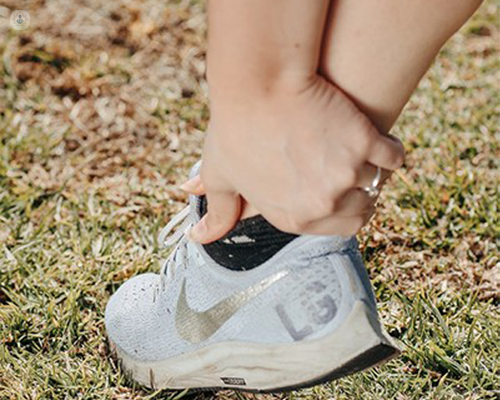What is Achilles tendonitis? An expert explains
Written by:Achilles tendonitis can cause pain and swelling around the back of the lower calf and heel. The condition requires careful attention and a staggered return to exercise in order for the patient to make a full recovery. In this expert guide to Achilles tendonitis, renowned consultant orthopaedic surgeon Mr Bal Dhinsa sheds light on the symptoms and risk factors associated with the condition. The leading specialist additionally explains how Achilles tendonitis can be treated and when surgical intervention is required.

What is Achilles tendonitis?
With overuse or repetitive strain, the Achilles tendon can be injured and even develop a tear. The Achilles tendon is found along the back of the calf’s muscle and connects to the heel bone. When injured, it can heal with scar tissue leading to localised swelling of the tendon. This can occur at either the site of Achilles insertion into the calcaneum (insertional tendinopathy) or within its mid-substance (non-insertional Achilles tendinopathy).
What are the main associated risk factors?
As we are seeing a return to sporting activities after lockdown, some key factors are being highlighted; the importance of a graduated training programme, appropriate ‘build-up’ and the use of the correct equipment (footwear). When someone suddenly returns to high-velocity activity or increased frequency, they are at risk of sustaining damage to the tendon. Additionally, following an injury or sprain, should the individual return to activity too quickly, they are at greater risk of further injury.
Following a comprehensive rehabilitation programme is essential, as is an understanding between the individual and therapist about the need to not rush to return to pre-injury level until fully recovered. Unfortunately, this year there have been numerous examples in professional sports of players suffering a rupture of the Achilles tendon following an early return to sports after a ‘calf strain’.
What are the main symptoms?
Typically, there is pain around the injured area with swelling which is often worse in the morning, before stretching, and after activity. There may be thickening seen over the area of inflammation and this can make wearing footwear uncomfortable.
What are the available treatment options? When is surgery required?
Initial management of Achilles tendonitis includes making changes to the activities you partake in, incorporating rest periods, modification of footwear with heel lifts and stretching exercises. Analgesics (painkillers) and non-steroidal anti-inflammatory medication (NSAIDs) may also be used. Early physiotherapy will be instigated to help with the recovery.
The next steps in management could involve an injection of high-volume fluid around the tendon under ultrasound guidance. This helps to free the paratenon sheath from the tendon, which can become inflamed and may adhere to the tendon. An alternative is an extracorporeal shock wave to help break down the scarring that is often present with inflammation and allows the stretching exercises to be carried out effectively.
With persistent pain and swelling, surgical intervention can be considered. Depending on the location of the inflammation, the necessary surgical procedure varies.
For patients with non-insertional tendinopathy, the unhealthy tendon is debrided and repaired. However, in cases of insertional tendinopathy, the Achilles tendon needs to be lifted from its insertion, debrided and the Haglund’s bump (calcaneal bony prominence) resected prior to reattaching the tendon back to the calcaneum.
Mr Dhinsa is one of the UK’s leading consultant orthopaedic surgeons who specialise in the treatment of sports injuries. If you are seeking treatment for Achilles tendonitis and wish to schedule a consultation with Mr Bal Dhinsa, you can do so by visiting his Top Doctors profile.


